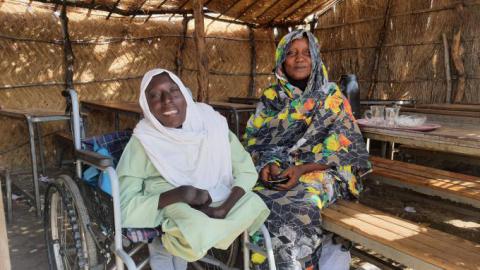جودة التعليم للأطفال ذوي الإعاقة: قصة بشاير وهي تواصل تعليمها | Quality Education for Children with Disabilities: The Story of Bashayir Continuing Her Schooling

بدأت بشائر بالذهاب إلى المدرسة عندما كانت في السابعة عشرة من عمرها. كان هذا قبل عام من الان عندما انتقلت من (جولي) بجنوب السودان إلى ولاية النيل الأزرق. وهي تعيش الآن مع خالتها التي تعتني بها. بشائر تذهب الى مدرسة تدعمها منظمة إنقاذ الطفولة من خلال برنامج تحسين جودة التعليم بدعم من الاتحاد الاوربي في السودان. منذ زمن بعيد ، كان حلم بشاير الأكبر هو الذهاب إلى المدرسة. ومع ذلك ، لم يكن هذا أولوية بالنسبة لوالديها. كان والدها يعاني من مشاكل نفسية وطرد ابنته وزوجته من منزلهما المشترك. توضح بشائر: "مرض والدي جعله يرسلني أنا ووالدتي بعيدًا، لكن بعد الانتقال إلى النيل الأزرق تحسن الوضع وقمت بإرتياد المدرسة المجاورة." الآن يمكنها أخيرًا الدراسة وهي متحمسة جدًا بشأن مستقبلها: "أنا أستمتع بالمدرسة كثيرًا وأحب بيئتها. أريد أن أصبح طبيبة عندما أكبر ". وتضيف خالتها: "بشائر تحب الذهاب إلى المدرسة وهي متحمسة لوجودها هناك. من قبل كانت تبكي كل يوم وتطلب الذهاب إلى المدرسة للتعلم والتواجد مع أصدقائها ". يدعم زملائها في الفصل وأبناء خالتها بشائر، لأنه ليس من السهل عليها التنقل. يتناوبون على دفع كرسيها المتحرك حتى تتمكن من الوصول إلى مبنى المدرسة. تقول خالتها: "في وقت الإفطار، يحضرونها إلى المنزل لتناول الطعام وبعد ذلك، يعيدونها إلى المدرسة مرة أخرى". تخضع مدرسة بشائر حاليًا لأعمال بناء إضافية من قبل منظمة إنقاذ الطفولة لبناء صفوف ومراحيض جديدة. كان فصلها مصنوعًا من القش، مما يجعله عرضة للرياح والحرارة، مما يؤثر على جودة التعلم. بدأ العمل مؤخرًا، لكنه يسير بخطى سريعة. قريباً ستتمكن بشائر من الدراسة في بيئة مناسبة وآمنة. الهدف الرئيسي من برنامج بناء المدارس المستهدف ضمن مشروع تحسن جودة التعليم هو المساعدة في تحسين البنية التحتية للمدارس وبيئات التعلم. يستهدف البرنامج المدارس الأكثر حرمانًا مع التركيز على التعليم الابتدائي. يهدف البرنامج للوصول إلى 62,500 طالب وطالبة في أربع ولايات (الخرطوم، النيل الأزرق، البحر الأحمر، جنوب كردفان) لبناء 83 فصلاً دراسيًا وسياجًا و 54 مرحاضًا ومصدرًا للمياه و 177 حملة تعبئة و 8 منشآت شمسية، بالإضافة إلى تقديم الدعم إلى 160 مدرسة. Bashayir (left) started going to school when she was 17 years. This was about a year ago when she relocated from Gulli, South Sudan, to Blue Nile state. She is now living with her aunt, who is taking care of her, and visits a school that is supported by Save the Children through the European Union in Sudan-funded Education Quality Improvement Programme (EQUIP). Since long ago, Bashayir’s biggest dream was to go to school. Yet, for her parents this was never a priority. Her father was struggling with mental health problems and kicked his daughter and wife out of their common home. She explains: “My father’s illness caused him to send me and my mother away, but after moving to Blue Nile the situation has improved and I visit the nearby school” Now she can finally study and is very excited about her future: “I am enjoying school a lot and I like the environment. I want to be a doctor when I grow up”. Her aunt adds: “Bashayir really loves going to school and is excited to be there. Before, she used to cry everyday asking to go to school to learn and to be with her friends.” Her classmates and her cousins support Bashayir, because it is not easy for her to move around. They take turns in pushing the wheelchair so that she can reach the school building. Her aunt says: “At breakfast time, they bring her home to eat and after, they take her back to school again”. Bashayir’s school is currently undergoing additional construction work by Save the Children to build new classes and latrines. Her class was made of hay, which leaves it vulnerable to wind and heat, affecting the learning quality. The work started recently, but is moving at a fast pace. Soon Bashayir will be able to study in a proper and safe environment. The main objective of the targeted school construction programme, within the EU EQUIP project, is to help improve the schools’ infrastructure and learning environments. The programme targets the most under-privileged schools, with a focus on primary education. The EQUIP program aims to reach 62.500 students in four states, to construct 83 classrooms and fences, 54 latrines and water sources, 177 mobilisation campaigns, 8 solar installations as well as the provision of grants to 160 schools.
 Sudan
Sudan